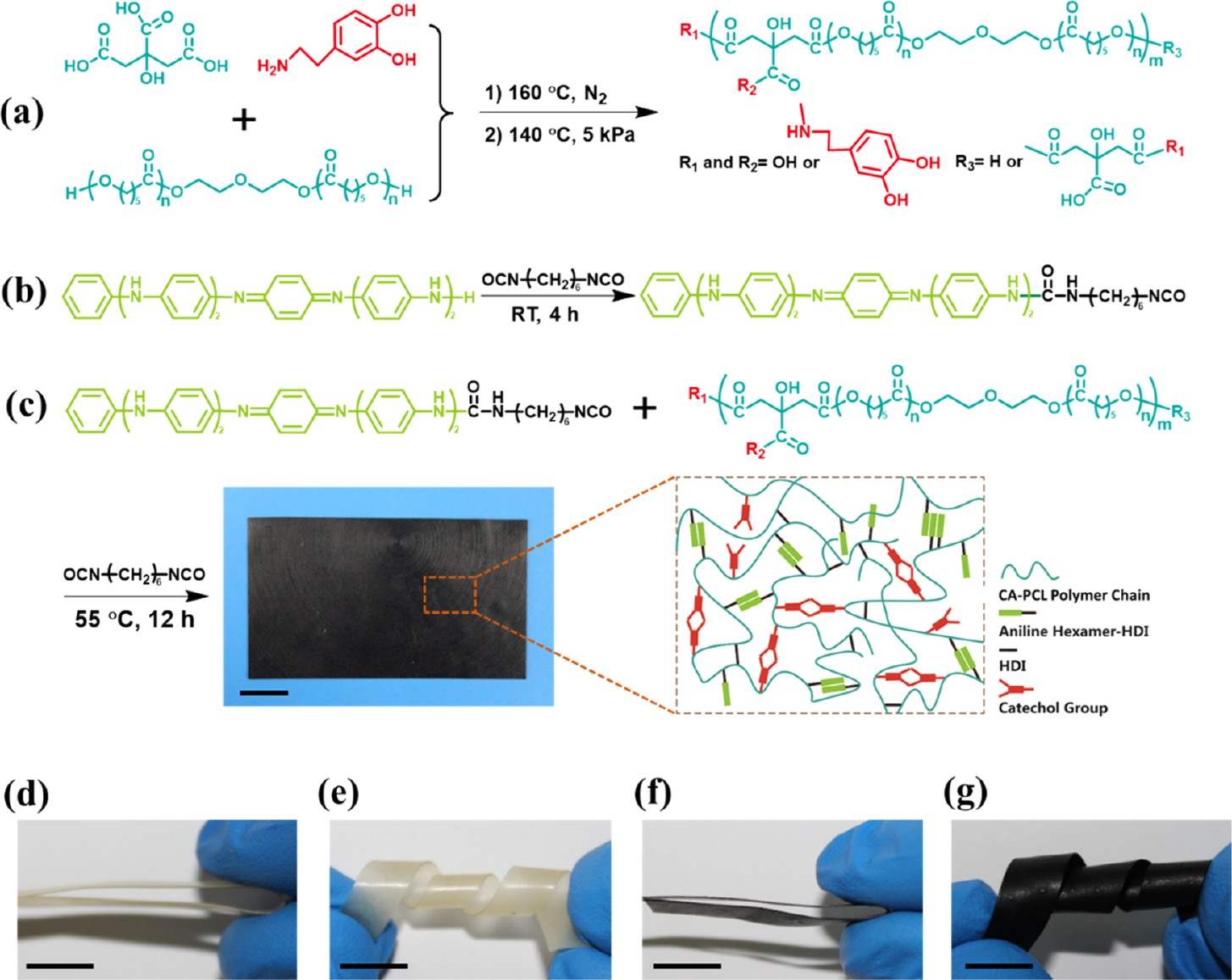|
生物活性电活性聚氨酯弹性体热力学及生物学研究
ACS Appl. Mater. Interfaces 2017, 9, 29595−29611 PCL由于优异的生物相容性、弹性,价格低廉被广泛应用于软组织过程,如心脏、肌肉、神经、膀胱组织工程,但长期循环应变导致塑性形变及断裂,亲水性差、生物活性低限制了进一步应用。通过熔融缩聚,将低分子量PCL二元醇及柠檬酸合成Tm可调的生物降解性弹性体,其在生理条件下具有形状记忆能力,进一步通过微创手术植入体内。通过化学接枝方法,将多巴胺引入弹性体,提高材料的亲水性及生物活性。此外,对电信号响应的细胞(心肌、骨骼肌、神经细胞),材料电活性影响细胞行为,提高特定细胞反应,将苯胺齐聚物引入弹性体,提高电活性。 最近,西安交通大学郭保林团队成功制备一系列柠檬酸、PCL、多巴胺及苯胺六聚体组成生物活性电活性形状记忆聚氨酯弹性体(将苯胺六聚体引入到HDI交联的CA-PCL-DA预聚体中)。通过调节AH含量,弹性体湿性下电导率可在5Í10-6~17.2Í10-4S/m范围内变化,降解性:55.4%~82.3%,模量:3.6 ~ 13.7MPa,应力:10.6 ~ 21.2MPa,断裂伸长率:360 ~ 550%。弹性体具有良好的形状记忆性,可在20℃暂时保持固定形状,在体温恢复形状。DA及CAS掺杂AH的引入可增强弹性体的亲水性及保水性。此外,DA及AH对于成肌细胞粘附、增殖及分化具有增强协同效应,弹性体在体内有微弱炎症反应,对于电信号敏感软组织工程有广泛的应用前景。 Poly (ε-caprolactone) (PCL), a synthetic thermoplastic polyester elastomer with good biocompatibility, widespread usage, and low cost, has been widely used in soft tissue engineering, such as cardiac tissue engineering, muscle tissue engineering, nerve tissue engineering, and bladder tissue engineering. However, its mechanical characteristics don’t meet the native soft tissues’ requests due to its plastic deformation and failure when exposed to long-term cyclic strain, limiting their performance in soft tissue engineering applications. Over the past decades, a series of biodegradable polyester elastomers were developed via melting polycondensation of low molecular polycaprolactone diols (PCL) and citric acid will combine the characteristic properties of PCL and poly(polyhydric alcohol-co-polyatomic acid) to develop good candidate materials for soft tissue engineering. To improve elastomer’s bioactivity, dopamine functionalized elastomers used for tissue engineering. Electroactivity of materials is also a vital property that can affect cell behavior, especially for electrical-signal-sensitive cells, which proposes the scaffolds with electroactivity to enhance specific cell responses. Thus, introduction of electroactive aniline oligomers into dopamine-functionalized polyurethane elastomers will result in dopamine-incorporated dual bioactive electroactive shape memory polyurethane elastomers Recently, the Guo Baolin team who come from Xi’an Jiaotong University developed a series of dopamine-incorporated dual bioactive electroactive shape memory polyurethane elastomers based on a hexamethylene diisocyanate (HDI)-crosslinked poly (citric acid-co-polycaprolatone-co-dopamine) (CA-PCLDA) prepolymer and an aniline hexamer (AH). The elastomers showed adjustable wet conductivity from 5 × 10−6 to 17.12 × 10−4 S/m by changing the AH content, which was similar to that of human physiological environments. The synthesized elastomers exhibited tunable degradation profiles and moderate modulus between 3.6 and 13.7 MPa. Moreover, the elastomers showed adjustable stress from 10.6 to 21.2 MPa and elongation from 360 to 550% by changing the AH content in the elastomers. Furthermore, the CA-PCL, CA PCL-DA0.3, and CA-PCL-DA-g-AH elastomers presented good shape memory capability, which kept stable temporary shape at 20 °C and recovered their shape under body temperature. The cell adhesion and proliferation results demonstrated the good cytocompatibility of the elastomers, and incorporation DA and suitable content of AH in the CA-PCL elastomer showed a synergetic effect to enhancing cell adhesion, proliferation, and myogenic differentiation of C2C12 cells. All of the developed elastomers with or without DA and AH showed just a mild host response in vivo. All of the results revealed that the prepared dual bioactive dopamine incorporated electroactive shape memory elastomers are promising materials for electrical-signal sensitive soft tissue engineering applications, such as skeletal muscle regeneration. (闫欢欢)
|
